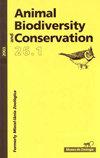哥伦比亚热带云雾林中美洲狮(美洲狮)及其潜在猎物的日常活动模式
IF 1
4区 环境科学与生态学
Q3 BIODIVERSITY CONSERVATION
引用次数: 4
摘要
安第斯山脉北部的生态系统面临着前所未有的栖息地丧失。美洲狮是该地区的顶级捕食者,发挥着关键的生态功能,如种群控制和资源便利化。然而,人们对该物种的时间生态位及其对热带猎物行为的影响知之甚少。我们假设,在哥伦比亚安第斯山脉中部的云雾林中,美洲狮及其猎物的活动模式之间存在联系。我们安装了61个相机陷阱,使用条件核密度函数来估计美洲狮和七种潜在猎物的日常活动曲线之间的重叠程度。美洲狮、armadillos、山地帕卡和白耳负鼠主要在夜间活动,黄昏活动很少,时间重叠度高。中美洲的阿古提、山地柯蒂、小马鹿和考卡关与美洲狮表现出主要的昼夜活动和时间划分。作为机会主义捕食者,美洲狮能够通过捕食黄昏和夜间物种来最大限度地提高觅食效率。这种高地捕食者的保护在很大程度上取决于对其本土猎物的适当管理。本文章由计算机程序翻译,如有差异,请以英文原文为准。
Daily activity pattern of pumas (Puma concolor) and their potential prey in a tropical cloud forest of Colombia
Ecosystems in the northern Andes face unprecedented habitat loss. Pumas are the top predators in the region and exert key ecological functions, such as population control and resource facilitation. However, little is known about the temporal niche of the species or its effects on behaviour of prey in the tropics. We hypothesized that there is a link between the activity patterns of pumas and their prey in a cloud forest of the Central Andes of Colombia. We installed 61 camera traps to estimate the degree of overlap between the daily activity curves of pumas and seven potential prey species, using conditional kernel density functions. Pumas, armadillos, mountain pacas, and white–eared opossums were mainly nocturnal, with little crepuscular activity and high temporal overlap. Central American agouti, mountain coati, little red brocket deer, and Cauca guan displayed a predominantly diurnal activity and temporal partitioning with pumas. As opportunistic predators, pumas were able to maximize foraging efficiency by preying on the crepuscular and nocturnal species. Conservation of this highland predator will largely depend on the suitable management of its native prey.
求助全文
通过发布文献求助,成功后即可免费获取论文全文。
去求助
来源期刊

Animal Biodiversity and Conservation
农林科学-动物学
CiteScore
2.00
自引率
0.00%
发文量
21
审稿时长
>12 weeks
期刊介绍:
Animal Biodiversity and Conservation (antes Miscel·lània Zoològica) es una revista interdisciplinar, publicada desde 1958 por el Museu de Ciències Naturals de Barcelona. Incluye artículos de investigación empírica y teórica en todas las áreas de la zoología (sistemática, taxonomía, morfología, biogeografía, ecología, etología, fisiología y genética) procedentes de todas las regiones del mundo. La revista presta especial interés a los estudios que planteen un problema nuevo o introduzcan un tema nuevo, con hipòtesis y prediccions claras, y a los trabajos que de una manera u otra tengan relevancia en la biología de la conservación. No se publicaran artículos puramente descriptivos, o artículos faunísticos o corológicos en los que se describa la distribución en el espacio o en el tiempo de los organismes zoológicos.
 求助内容:
求助内容: 应助结果提醒方式:
应助结果提醒方式:


